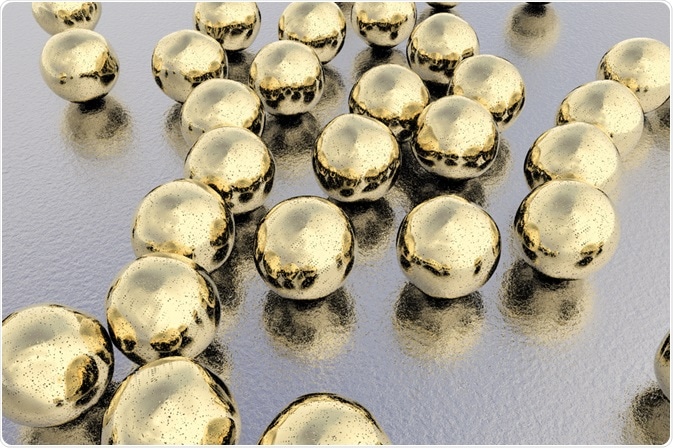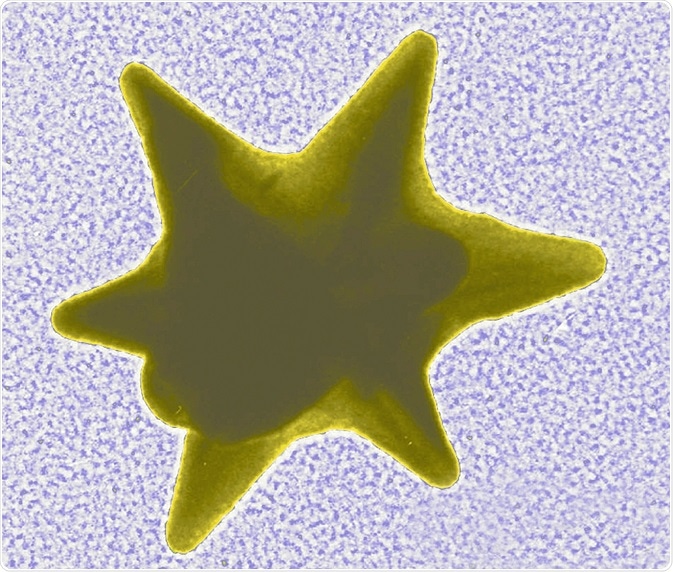Nanostars are a type of nanoparticle consisting of a spherical core and multiple branches, resembling a ‘star’.
Nanoparticles are defined by their size, 1-100 nm, and nanostars have been produced consisting entirely of a mixture of gold, silver, platinum, palladium, and Rhodium, among other metals.
Other materials such as silica may then coat the nanostar, or act as the spherical core from which metallic branches are grown.
 Kateryna Kon / Shutterstock
Kateryna Kon / Shutterstock
Synthesis of nanostars
Two general methods exist for the synthesis of shaped nanoparticles, one-pot or seeded-growth methods.
One-pot methods attempt to synthesize the nanoparticle in its final form from a metallic precursor and reducing agents in a single reaction, whereas seeded-growth methods utilize a pre-made nanoparticle as seeds upon which additional material is deposited.
Seeded-growth methods tend to produce more monodisperse and stable particles as conditions can be more easily controlled, and the size of the nanoparticle seed can be ensured to be more consistent before growth is initiated.
Common metallic precursors utilized in the production of gold nanostars include HAuCl4, AgNO3, and PtCl2, depending on the metal that the branches are to be made from.
Sodium trinitrate and ascorbic acid are two chemicals frequently used to reduce the metal ions in the precursors to their metallic state, which allows deposition onto the nanoparticle surface.
Additional chemicals are often required to direct the anisotropic growth of the nanoparticle. Spherical nanoparticles actually consist of several flat crystallographic planes, technically making them a polyhedron.
The crystallographic faces have different arrangements of atoms, and thus different electron densities and reactivity.
Molecules such as cetyltrimethylammonium bromide or hydroquinone are used to either block or encourage growth on a particular crystal plane, ensuring the growth of well-defined branches while maintaining the smaller spherical core of the particle.
 Transmission electron microscope (TEM) image of a star-shaped gold nanoparticle.
Transmission electron microscope (TEM) image of a star-shaped gold nanoparticle.
Surface plasmon resonance
Gold and silver are plasmonic materials, able to produce a phenomenon known as surface plasmon resonance when struck with incident light of greater wavelength than the diameter of the nanoparticle.
During surface plasmon resonance, the electron cloud surrounding the nanoparticle oscillates due to the electromagnetic field of the incident light firstly displacing the cloud, then undergoing restoring force due to the positively charged particle.
When incident light matches the frequency of these oscillations it is largely scattered or absorbed through interactions with the oscillating electrons.
Nanostars created from gold or silver concentrate electron density at the sharp tips of their branches, massively increasing the interaction cross-section of the particle with photons.
This also causes the surface plasmon resonance generated by nanostars to be red-shifted compared with a spherical particle, meaning that light of a lower frequency is in resonance with the electrons.
Longer, sharper, and more numerous branches progressively red-shift the surface plasmon resonance further, as a greater number of exposed atoms associated with sharp corners or highly curved regions increase the electron density in this area.
Applications of nanostars
Nanoparticles shaped into stars are desirable in any role where their larger surface-to-volume ratio and interaction cross-section than spherical particles is considered valuable.
Many nanoparticles are used in catalytic applications due to their high surface area and reactivity, with nanostars representing a further improvement in this aspect.
The larger interaction cross-section of nanostars compared with spherical nanoparticles provides an improvement in radiation dose enhancement, where gold nanostars may be used to focus a beam of radiation, lowering the overall dose of radiation received by a patient during radiation therapy.
The wavelength of surface plasmon resonance for gold nanostars is in the region of 600 – 900 nm, which is known as the ‘tissue transparency window’, as this is the wavelength of light that is most penetrating through organic tissue.
This provides promising applications in bioimaging, acting as contrast or sensing agents.
Additionally, gold nanostars provide surface enhanced Raman scattering enhancement, improving the resolution and detection ability of this spectroscopic method.
Further Reading
Last Updated: Oct 1, 2018